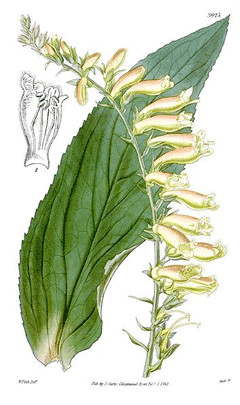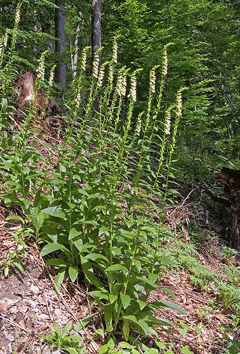 |
|
http://commons.wikimedia.org/wiki/File:Digitalis_lutea.jpg |
 |
| http://commons.wikimedia.org/wiki/User:BerndH |
Translate this page:
Summary
Physical Characteristics

 Digitalis lutea is a PERENNIAL growing to 0.6 m (2ft) by 0.3 m (1ft in). It is in flower in July. The species is hermaphrodite (has both male and female organs) and is pollinated by Bees.
Digitalis lutea is a PERENNIAL growing to 0.6 m (2ft) by 0.3 m (1ft in). It is in flower in July. The species is hermaphrodite (has both male and female organs) and is pollinated by Bees.
Suitable for: light (sandy), medium (loamy) and heavy (clay) soils. Suitable pH: mildly acid, neutral and basic (mildly alkaline) soils. It can grow in semi-shade (light woodland) or no shade. It prefers dry or moist soil and can tolerate drought.
UK Hardiness Map
US Hardiness Map
Synonyms
Plant Habitats
Woodland Garden Dappled Shade; Shady Edge;
Edible Uses
References More on Edible Uses
Medicinal Uses
Plants For A Future can not take any responsibility for any adverse effects from the use of plants. Always seek advice from a professional before using a plant medicinally.
Cardiac Diuretic Stimulant Tonic
Yellow foxglove is little used in herbal medicine but is in fact a less toxic alternative to the purple and woolly foxgloves (D. purpurea and D. lanata) which are widely used in the treatment of heart complaints[254]. The yellow foxglove has similar medical actions, but its alkaloids are more readily metabolized and flushed out of the body[254]. The leaves are cardiac, strongly diuretic, stimulant and tonic[7, 9, 46, 61]. They are used in the treatment of a weakened or failing heart, increasing the strength of contraction, slowing and steadying the heart rate and lowering blood pressure by strongly stimulating the flow of urine - which reduces overall blood volume[254]. The leaves of plants in their second year of growth are harvested in the summer and dried for later use[7]. This remedy should be used with caution and only under the supervision of a qualified practitioner, excessive doses can prove fatal[7, 254]. See also the notes above on toxicity.
References More on Medicinal Uses
The Bookshop: Edible Plant Books
Our Latest books on Perennial Plants For Food Forests and Permaculture Gardens in paperback or digital formats.

Edible Tropical Plants
Food Forest Plants for Hotter Conditions: 250+ Plants For Tropical Food Forests & Permaculture Gardens.
More

Edible Temperate Plants
Plants for Your Food Forest: 500 Plants for Temperate Food Forests & Permaculture Gardens.
More

More Books
PFAF have eight books available in paperback and digital formats. Browse the shop for more information.
Shop Now
Other Uses
Preservative
An infusion of the plant added to the water in the vase will prolong the life of cut flowers[54]. When grown near root crops the roots will store better[54].
Special Uses
References More on Other Uses
Cultivation details
An easily grown plant, succeeding in ordinary garden soil, especially if it is rich in organic matter[1]. It also succeeds in dry soils and, once established, is drought tolerant[188, 190]. It prefers semi-shade but succeeds in full sun if the soil is moist[188, 200]. Members of this genus are rarely if ever troubled by browsing deer or rabbits[233]. The yellow foxglove is a good companion plant, stimulating the growth of nearby plants[54]. Root crops grown near to this plant will store better[54].
References Carbon Farming Information and Carbon Sequestration Information
Temperature Converter
Type a value in the Celsius field to convert the value to Fahrenheit:
Fahrenheit:
The PFAF Bookshop
Plants For A Future have a number of books available in paperback and digital form. Book titles include Edible Plants, Edible Perennials, Edible Trees,Edible Shrubs, Woodland Gardening, and Temperate Food Forest Plants. Our new book is Food Forest Plants For Hotter Conditions (Tropical and Sub-Tropical).
Shop Now
Plant Propagation
Seed - surface sow early spring in a cold frame. The seed usually germinates in 2 - 4 weeks at 20°c[175]. When they are large enough to handle, prick the seedlings out into individual pots and plant them out in the summer.
Other Names
If available other names are mentioned here
Native Range
EUROPE: Austria, Belgium, Switzerland, Germany, Italy, Spain, France (incl. Corsica)
Weed Potential
Right plant wrong place. We are currently updating this section.
Please note that a plant may be invasive in one area but may not in your area so it's worth checking.
Conservation Status
IUCN Red List of Threatened Plants Status :

Growth: S = slow M = medium F = fast. Soil: L = light (sandy) M = medium H = heavy (clay). pH: A = acid N = neutral B = basic (alkaline). Shade: F = full shade S = semi-shade N = no shade. Moisture: D = dry M = Moist We = wet Wa = water.
Now available:
Food Forest Plants for Mediterranean Conditions
350+ Perennial Plants For Mediterranean and Drier Food Forests and Permaculture Gardens.
[Paperback and eBook]
This is the third in Plants For A Future's series of plant guides for food forests tailored to
specific climate zones. Following volumes on temperate and tropical ecosystems, this book focuses
on species suited to Mediterranean conditions—regions with hot, dry summers and cool, wet winters,
often facing the added challenge of climate change.
Read More
Expert comment
Author
L.
Botanical References
200
Links / References
For a list of references used on this page please go here
Readers comment
| Add a comment |
|
If you have important information about this plant that may help other users please add a comment or link below. Only comments or links that are felt to be directly relevant to a plant will be included. If you think a comment/link or information contained on this page is inaccurate or misleading we would welcome your feedback at [email protected]. If you have questions about a plant please use the Forum on this website as we do not have the resources to answer questions ourselves.
* Please note: the comments by website users are not necessarily those held by PFAF and may give misleading or inaccurate information.
To leave a comment please Register or login here All comments need to be approved so will not appear immediately.
|
Subject : Digitalis lutea
|
|
|
|